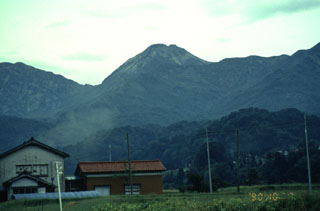Report on Niigata-Yakeyama (Japan) — December 1991
Bulletin of the Global Volcanism Network, vol. 16, no. 12 (December 1991)
Managing Editor: Lindsay McClelland.
Niigata-Yakeyama (Japan) Increased steaming
Please cite this report as:
Global Volcanism Program, 1991. Report on Niigata-Yakeyama (Japan) (McClelland, L., ed.). Bulletin of the Global Volcanism Network, 16:12. Smithsonian Institution. https://doi.org/10.5479/si.GVP.BGVN199112-283090
Niigata-Yakeyama
Japan
36.921°N, 138.036°E; summit elev. 2400 m
All times are local (unless otherwise noted)
Steaming from vents near the summit has increased slightly since October. A seismometer installed near the volcano on 20 December recorded only 1 weak earthquake by 16 January. Steam emission has continued since late April 1987 (figure 1), when a small ash ejection occurred. Larger plumes in April 1989 also included ash.
Geological Summary. Niigata-Yakeyama, one of several Japanese volcanoes named Yakeyama ("Burning Mountain"), is an andesitic-to-dacitic lava dome in Niigata prefecture in west-central Honshu, about 20 km from the coast. The volcano was constructed on a base of Tertiary mountains beginning about 3,100 years ago. Three major eruptions in the past 1,000 years have produced pyroclastic flows and lava flows that traveled mainly down the Hayakawa river valley to the N and NW. The first of these eruptions, in 887 CE (and possibly 989 CE), produced the Hayakawa pyroclastic flow, which reached the coast, and the massive Mae-yama lava flow, which traveled about 6.5 km down the Hayakawa river valley. The summit lava dome was emplaced during the 1361 CE eruption, and the last magmatic eruption took place in 1773 CE. Eruptive activity since 1773 has consisted of relatively minor phreatic explosions from several radial fissures and explosion craters that cut the summit and flanks of the dome.
Information Contacts: JMA.

